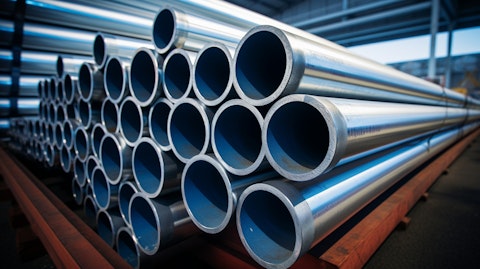Ascent Industries Co. (NASDAQ:ACNT) Q2 2025 Earnings Call Transcript August 7, 2025
Operator: Good afternoon, and welcome to Ascent Industries Second Quarter 2025 Earnings Call. Today’s speakers are CEO, Bryan Kitchen; CFO, Ryan Kavalauskas; and the company’s outside Investor Relations Advisor, Ralf Esper. We’ll begin with prepared remarks followed by Q&A. Before we go further, I would like to turn the call over to Ralf Esper as he reads the company’s safe harbor statement within the meaning of the Private Securities Litigation Reform Act of 1995 that provides important cautions regarding forward-looking statements. Ralf?
Ralf Esper: Thanks, Liz. Before we continue, I would like to remind all participants that the discussion today may contain certain forward-looking statements pursuant to the safe harbor provisions of the federal security laws. These statements are based on information currently available to us and are subject to various risks and uncertainties that could cause actual results to differ materially. Ascent advises all of those listening to this call to review the latest 10-Q and 10-K posted on its website for a summary of these risks and uncertainties. Ascent does not undertake the responsibility to update any forward-looking statements. Further, the discussion today may include non-GAAP measures. In accordance with Regulation G, the company has reconciled these amounts back to the closest GAAP-based measurement.
The reconciliations can be found in the earnings press release issued earlier today and posted on the Investors section of the company’s website at www.ascentco.com. Please note that this call is available for replay via a webcast link that is also posted on the Investors section of the company’s website. Now I would like to turn it over to our CEO, Bryan Kitchen, to walk you through the results and what’s driving continued momentum. Bryan?
J. Bryan Kitchen: Thanks, Ralf. Q2 marked a defining milestone in Ascent transformation. With the successful divestitures of both Bristol Metals and American Stainless Tubing, we’ve now fully exited all operating assets within the Tubular segment. The only remaining drag is our idle tubular facility in Munhall, Pennsylvania, a $2.1 million annualized headwind to adjusted EBITDA. We’re actively pursuing parallel paths to unlock that trapped cash and close this final chapter. Our portfolio is clean. Our focus is singular, is officially a pure-play specialty chemical company, purpose-built to scale, generate durable margin and deliver exceptional customer outcomes. But we didn’t just restructure the portfolio. We put it to work.
This quarter, we repurchased and retired nearly 6% of our outstanding shares. That’s not symbolic. It’s a statement of conviction. We believe in the long-term value of the platform we’ve built, and we’re backing it with decisive capital allocation. More importantly, we’ve delivered sequential improvements in revenue, gross profit, gross margin and adjusted EBITDA. A few highlights. Revenue increased $817,000 sequentially to $18.7 million, though fell short of the $21.4 million prior year comp, largely due to broader market softness. Gross profit rose $1.8 million from Q1 and $2.1 million versus the same quarter last year. Gross margin expanded 26.1%, up 888 basis points sequentially and 1,298 basis points year-over-year. Adjusted EBITDA increased $131,000 sequentially to a loss of $335,000 in the quarter, but fell short of prior year by $53,000.
And we achieved all of this despite absorbing $475,000 of Munhall-related costs in the quarter, excluding the asset impairment on the right-of-use asset on the facility. These teams are not episodic. They reflect disciplined execution, strategic focus and a business model that’s working. We’re shifting mix to higher-margin opportunities, managing costs with purpose and turning commercial wins into real operating leverage. Our operations team continues to drive momentum. labor, overhead and production variances improved by more than $1.2 million year-over-year, while service levels hit all-time highs despite a more complex and more dynamic product mix. In Q2, our team developed process modifications that drove a 5% yield improvement across a targeted product basket, unlocking a $250,000 in annualized gross profit and a meaningful reduction in cycle times, test continuous improvement in action.
Strategic sourcing remains a standout strength, consolidating vendors, qualifying new sources and continuing to lower raw material costs without sacrificing reliability. As reported last quarter, roughly 95% of our revenue is supported by domestically produced raw materials, dramatically reducing our exposure to tariff volatility. And on the commercial side, momentum continues to build. In Q2, we secured over $3.1 million of annualized new revenue at a 29% gross margin, well above historical averages. These wins span oil and gas, HI&I, Pulp and Paper and CASE, all markets where our value proposition continues to resonate. Roughly 1/3 of that growth came from product sales, 2/3 came from high-quality custom manufacturing engagements. Notably, 88% of those wins were expansion with existing accounts, further proof that our model is earning trust and expanding share of wallet.
This is where Chemicals as a Service comes to life. We’re not just selling products. We’re solving problems. We’re creating formulations offering blending and packaging, managing logistics, ensuring regulatory compliance and delivering it all with speed and precision. We do this across small and large volume requirements in ways that traditional manufacturers won’t and distributors simply can’t. It’s a hybrid model that fuses custom manufacturing high service execution, and it’s working. Underpinned by a $25 million increase in our selling project pipeline, the $3.1 million of new business won in Q2 is expected to grow significantly into 2026. And with no significant new fixed cost burden, each incremental win translates directly to meaningful profit.
That’s what makes this model powerful is that it’s scalable. Every customer engagement, every sourcing win, yield improvement and process improvement builds muscle. The platform that we’re building compounds in strength and the value that we create for our customers multiplies as we grow. Across the moments that matter, we win because we respond faster than traditional manufacturers, especially in the early stages like discovery and development, where our technical bench and speed help customers move from problem to solution. We offer services far beyond what distributors can spanning the full range of the value chain from reaction-based product development to logistics to regulatory compliance and reformulation. We lead with service and agility, not line cards.

We solve problems most platforms aren’t built to see because we designed our model around every stage of customer loyalty, discovery, contracting, fulfillment and life cycle support. And we do it all whilst expanding margin and strengthening reliability for our customers, not by chance, but by design with process automation, dual source qualification and operational excellence built into everything we do. These moments that matter are where loyalty is earned and retained and Ascent is winning because we’ve made them a blueprint for scalable, profitable growth. Without question, the strategic recapitalization of SG&A and the operational horsepower behind it has been central to our transformation. Over the past year, we’ve redirected investment into roles that enable and unlock growth, technical sales, business development, engineering, strategic sourcing, marketing, business operations and customer care.
And while the total SG&A has remained effectively flat, the return on that spend has fundamentally changed. These teams are now delivering measurable results, new commercial wins, stronger margins, deeper customer penetration and all- time service levels. And we’re just getting started. We’re not building a traditional chemicals company. We’re building a performance platform engineered to solve the hardest problems across reaction chemistry, formulation, supply chain, compliance and fulfillment. From development to delivery, we own the outcome. That’s why we’re gaining share. That’s why margins are expanding, and that’s why the best chapters of our story are still ahead. Before I pass it over to Ryan, I want to thank our incredible team at Ascent, our superpower, who has continued to demonstrate remarkable grit, hustle and the drive to win.
I also want to thank our investors for the trust and confidence that you place in both Ryan and I and the team that we’ve assembled. With that, I’ll turn it over to Ryan to provide you a bit more context behind our financial performance. Ryan, over to you.
Ryan Kavalauskas: Thanks, Bryan, and good afternoon, everyone. As Bryan laid out, Q2 was a milestone in Ascent’s transformation, and the financials are beginning to reflect the benefits of our disciplined repositioning. Today, I’ll walk through our second quarter results and highlight where structural improvements are driving sustainable margin and operating leverage even in the face of persistent macro headwinds. Revenue from continuing operations was $18.7 million, down 13% versus Q2 of last year, but up nearly 5% sequentially from Q1 of 2025. The year-over-year decline was primarily volume driven, reflecting softer demand across key end markets, though pricing actions taken over the past several quarters helped partially offset the impact.
This top line momentum quarter-over-quarter, albeit measured, is especially notable given the broader macro chemical environment where manufacturing activity has largely languished below expansion territory over the past 2 years, with only a brief re-spike in early 2025 when PMI readings edged above 50 in January and February. The sector has since reverted to contraction with July 2025 registering 48. Within that context, our sequential growth signals early traction from our focus on higher-value commercial engagements and more resilient end market exposure. Gross profit increased to $4.9 million with gross margin expanding to 26.1%, up from 17% in Q1 and 13.1% in the prior year period. However, it’s important to note that in June, we reclassified approximately $1.2 million of costs from cost of goods sold to SG&A to more accurately reflect the administrative nature of certain Munhall, Palmer and SBT support resources.
Adjusting for this reclassification, normalized gross margins for Q1 and Q2 in 2025 would have been approximately 21% and 22.4%, respectively, still representing strong year-to-date expansion. This improvement in margin quality is being driven by favorable pricing, continued reductions in raw material input costs through strategic sourcing and operational efficiencies across our sites. Despite a 29.6% year-over-year decline in volume, driven by both market conditions and our deliberate exit from lower value streams, our pricing actions and cost management efforts are creating real operating leverage. Turning to SG&A. Expenses totaled $6.4 million in Q2, up from $4.6 million in the prior year period, but this year-over-year comparison is skewed by 2 factors: first, the $1.2 million reclassification of support-related COGS into SG&A.
Second, the re-inclusion of remaining ongoing Munhall expenses in continuing operations this year, whereas it was previously captured in discontinued operations. When you remove these combined effects and isolate core SG&A, excluding Munhall, Palmer and SBT-related overhead, underlying expenses were actually down approximately $400,000 year-over-year. That’s despite continued investments in commercial, technical and operational talent as well as system and process improvements designed to scale the platform. These margin gains paired with disciplined cost management are beginning to show up in our bottom line. Adjusted EBITDA for the quarter was a loss of $300,000, flat to prior year. But again, this includes roughly $475,000 of Munhall- related costs now embedded in continuing operations.
Adjusting for these legacy site impacts, Q2 adjusted EBITDA would have been approximately positive $181,000. We believe this is a more accurate reflection of the earnings power of our core business and underscores the progress we’ve made in repositioning the cost structure. All of this progress is underpinned by a balance sheet that remains exceptionally well positioned to support our strategy. We ended Q2 with $60.5 million in cash, no debt and $13.4 million of availability under our revolver. We remain disciplined in our capital deployment, having repurchased over 644,000 shares in the quarter, nearly 6% of the company at an average price of $12.15 per share, while preserving flexibility for future growth investments or opportunistic M&A.
To wrap up, revenue improved sequentially despite muted macro conditions and lower volume. Gross margins expanded significantly year-to-date, even after adjusting for accounting reclassifications. Core SG&A is down year-over-year, reflecting disciplined execution and early operating leverage. Adjusted EBITDA would have been positive, excluding legacy site drag, and we expect continued improvement going forward. We’re confident in the underlying trajectory of the business, and we’re committed to sustaining this momentum through thoughtful execution and disciplined capital stewardship. With that, I’ll turn it back over to the operator for questions.
Q&A Session
Follow Ascent Industries Co. (NASDAQ:ACNT)
Follow Ascent Industries Co. (NASDAQ:ACNT)
Receive real-time insider trading and news alerts
Operator: [Operator Instructions] Our first question comes from the line of Adam Waldo from Lismore Partners.
Adam Waldo: Bryan, we had a chance to meet at an investor conference in Chicago in early June, and I appreciate your thoughtful answers to my questions. And I want to follow up on a couple of things in light of this quarter’s results release. First, as you think about the 2030 adjusted EBITDA margin target that you’ve laid out in your Planet MicroCap — showcase, pardon me, presentation of 15% net of public company overhead. What sort of revenue number are you contemplating there? And can that revenue number be achieved through the excess capacity you have within the existing footprint or would some of that revenue need to be acquired?
J. Bryan Kitchen: Yes. No, good question. I appreciate that, Adam. So outside of our — within our existing asset base, we’re confident that we can get to, let’s say, $120 million to $130 million of top line. And if you recall from the microcap deck, taking that down to gross margins of roughly 30% to 35% with SG&A at that level of nominally 15%, taking it down to adjusted EBITDA targets of about 15%. So we’re confident that within the existing asset base, we can get to, we can grow into about $120 million to $130 million, depending on mix.
Adam Waldo: And so how do you all sort of quantify and think about your near to intermediate-term new business pipeline over the next 12 to — call it, 18 months?
J. Bryan Kitchen: Yes. I guess, could you be more specific?
Adam Waldo: Well, I know your business is one in which you sort of combine more, what I’ll call spot market opportunities, but also some longer- term contracted business, right, with larger industrial clients and the like. So how should we think about the amount of organic revenue growth that — to which you feel you have line of sight through your new business pipeline as we look out over the next 12 to 18 months? Or is that pretty hard to quantify at this point?
J. Bryan Kitchen: Yes. I mean, look, this is something that we work on every day. So one of the data points that I referenced earlier was an increase in our selling project pipeline by about $25 million over the last quarter. And of that $25 million, it’s spread out across 4 to 5 different market segments. It’s a mix of both product sales as well as high-value custom manufacturing.
Adam Waldo: Okay. That’s tremendously helpful. Last question, if you’ll permit me, Bryan. In that investor conference in early June, you — in response to my question, you talked about an executive management equity compensation plan that was being finalized and was going to be presented to the Board. Has that been presented to the Board at this point for its review and consideration? And should we view the share repurchases of about 600,000 shares during the second quarter as having been done, a, because of the undervaluation of the stock, but b, to support that management equity incentive plan for sort of the next levels of management below the CEO and the CFO?
J. Bryan Kitchen: Yes, I’ll answer those questions in reverse. So the share buyback of about 6% of our outstanding shares is not related to any type of equity program for senior leaders within the company. That’s just purely based on the fact that we believe that this company is undervalued today, and it will be — it will only increase in value in the near term, so that’s part A. Part B, getting back to the question in hand, I mean, look, we have an existing equity program in place for Ryan and I, we’re at the final stages of advancing a broader equity program. And with the Compensation Committee’s help, that will be updated and refreshed each year.
Adam Waldo: Okay. And in terms of this year’s tranche of that then, would you expect that to be finalized with the Board Compensation Committee?
J. Bryan Kitchen: That’s already — yes, I mean that’s already been settled.
Adam Waldo: It’s already been set. Okay. So this is really for ’26?
J. Bryan Kitchen: Correct.
Operator: [Operator Instructions] Our next question comes from the line of [indiscernible].
Unidentified Analyst: Congratulations on the progress made this past quarter. So I know generally, the earnings for a chemical manufacturer are more stable than a tubular and would demand a higher multiple. So I don’t know if really the re-rating has happened yet. What do you see as the catalyst to get this get this higher?
J. Bryan Kitchen: Yes, I think it’s 3 things. I think it’s growth, growth and growth, right? So outside of addressing the lingering Munhall issue, which we are, our primary focus after stabilizing and kind of fixing the foundation last year is all about driving both organic and inorganic growth. And it’s been really encouraging to see just the enormous progress that our team has made over the past several quarters. But what I would say is the momentum that we have seen over the past quarter has just been incredible. So we’re very excited about the future, very excited about the work that the team is doing, and we’re very excited about the value proposition that we have that’s resonating with our customers.
Unidentified Analyst: Good to hear. And so do you think a return to profitability is in the cards for like, we’ll say, third or fourth quarter? I know earlier in the year, we were talking about that second quarter — or I mean, I’m sorry, third or fourth quarter of 2025.
J. Bryan Kitchen: I mean that’s certainly what we’re running and gunning towards. As Ryan indicated earlier, if you exclude the Munhall aspect, we’re effectively there. What I would say is the levels of profitability are cute. We’re not satisfied with that. So we’ve got much larger aspirations that we’re working towards.
Unidentified Analyst: Got it. So congratulations on making the Russell Index this year. Previous 2 times that Ascent made the Russell, the previous year was kicked out because of not having market cap — meeting the market cap requirements. So you think this year will be different, 2026, — do you think that will be different?
J. Bryan Kitchen: I hope with improved stability that will not be the case, but I can’t guarantee that.
Unidentified Analyst: Right. No, I understand. And then we’re talking a little bit — the previous caller talking a little bit about the Board. Do you think there would be some advantages to having a Board of Directors that consists of a chemical guy or a few chemical guys because after all, it’s a chemical company now.
J. Bryan Kitchen: Yes. I mean, look, like we’ve said over the course of the past year, our Board of Directors has been incredibly supportive of Ryan and I and the team that we’ve put in place over the past year and rolling into this year. Certainly, there’s a recognition that we do not have chemical industry representation on our current Board, and that’s being addressed.
Unidentified Analyst: Good. And then I think the — I’ve been following the story for 6, 7 years, probably more and been an investor for that time. So ASTI, the asset was essentially sold for less than what it was paid for years ago. And I would have to say the [indiscernible] purchase was probably an overpay considering it was bought at peak market. Do you think more discipline or do you think — it appears that you have more discipline now this time around when it comes to a potential purchase or acquisition.
J. Bryan Kitchen: I mean that’s certainly the plan, David. We’ve looked at a number of properties. We’ve gotten into LOIs. We’ve walked away because we couldn’t align on an appropriate value. So we’re — look, we’re not going to get into deal frenzy and just do a deal for the sake of doing a deal. We want to do the right deal. We want to do the right deal for our shareholders. We want to start off with something small as we’ve talked about before. We want to demonstrate to ourselves and to our shareholders that we can extract the contemplated growth synergies, extract the contemplated cost synergies before we get too far out ahead of ourselves. So I would look for smaller transactions before bigger transactions.
Unidentified Analyst: Got it. Makes sense. And then regarding the buyback, great amount of shares bought back last quarter. Do you see that happening in the future, big tranches like that? Or is this going to be a continuation of depending upon the order flow, picking up 100,000 shares per quarter if you have that type of volume?
J. Bryan Kitchen: Yes. I mean, look, we’re going to continue to operate within the existing buyback agreement, and we’ll continue to evaluate opportunities with the Board. But as you know, we’ve got a fair amount of dry powder right now, and we’d like to unleash that with inorganic growth opportunities. So — it’s not — just like we said before, it’s not an or, it’s an and.
Operator: [Operator Instructions] Your next question comes from the line of Adam Waldo with Lismore Partners.
Adam Waldo: A quick follow-up on the other gentleman’s line of questioning around the trade-offs — implicit trade-offs between deploying capital for M&A versus share buybacks. As you all get toward — we will get in the future towards the end of the time period of achieving filling the existing capacity footprint and reaching, call it, $120 million of annualized run rate revenue. How do you think about the M&A multiples as multiple of revenue and pre-operating expense synergy EBITDA that you would need to — which you would need to acquire companies to compare favorably with the risk-free rate of return available on your stock repurchases?
J. Bryan Kitchen: Sure. Ryan, do you want to jump in?
Ryan Kavalauskas: Yes. I mean the way we’re looking at M&A today from an inorganic perspective is we believe assets that we’ll be looking to acquire will be trading in that 6x to 8x EBITDA range. So we would like to stay at the lower end of that range when you take into account synergies just based on where we’re trading today and based on the value we can extract organically. So Bryan said, this is — it’s an and discussion. So we’ll always look at opportunistically buying back our shares. We’ll look at M&A, and we’ll like deals early that trend towards that lower end of that 6x to 8x range. I don’t think we’re in a position today to overpay or pay up for anything beyond that. Again, based on where we’re at organically, we’ve got a lot of room to grow there.
We’d like to invest back in the business where we see opportunities to find assets that can be accretive to growth at the lower end of that multiple range where synergies make sense, and there’s a lot of opportunities to expand geographically, market share-wise, what have you, that’s where we’ll focus. And they’ll be small out of the gate. We want to make sure the team continues to focus on organic growth. We have a lot of capacity to fill. We’re in no rush to go do a deal. We want to be very, very disciplined. Just like David said, there’s been deals in the past that we look at, and we just want to be very careful with how we look at deals going forward. So again, a lot of these deals earlier are going to be in that lower end of that 6x to 8x.
Again, closer to 6x, 7x when you pull in synergies. And that’s really where we focus M&A in the near term.
Adam Waldo: Okay. So really helpful to hear the philosophy there. And you made reference, Ryan, to 6x to 8x post-OpEx synergies. I just want to clarify that. And if so, what multiples would that look like pre-synergies so that we sort of think about the risk profile of a pre- synergies multiple, right, versus just buying back your own stock and expanding internally at a lower risk profile than integrating an acquisition and financing it, right?
Ryan Kavalauskas: Sure. Yes. I would not expect and I would not anticipate us paying anything over 8x or 9x earnings on a potential asset. I mean that would be pre-synergy. — where we would like to be post synergy is we’ll be pulling that down closer to that 6x to 7x. So that’s where we’ll focus in the early. Anything over that, we’re just not in a position right now to overpay for an asset, pay up for an asset. We just have too much idle capacity where we need to go out and make a bet that large based on what we know we can do internally. So I would say pre- synergies, 8x to 9x, I would not expect us to do anything more than that. And then post-synergies, where we’d like to be is in that 6x to 7x.
Operator: And at this time, this concludes our question-and-answer session. I would now like to turn the call back over to Mr. Kitchen for closing remarks.
J. Bryan Kitchen: Okay. Great. Thank you, Liz. We’d like to thank everyone for listening to today’s call, and we look forward to speaking with you again when we report out our second quarter — third quarter 2025 results. Thanks, and have a great afternoon.
Operator: Ladies and gentlemen, this does conclude today’s teleconference. You may disconnect your lines at this time. Thank you all for your participation.
Follow Ascent Industries Co. (NASDAQ:ACNT)
Follow Ascent Industries Co. (NASDAQ:ACNT)
Receive real-time insider trading and news alerts





